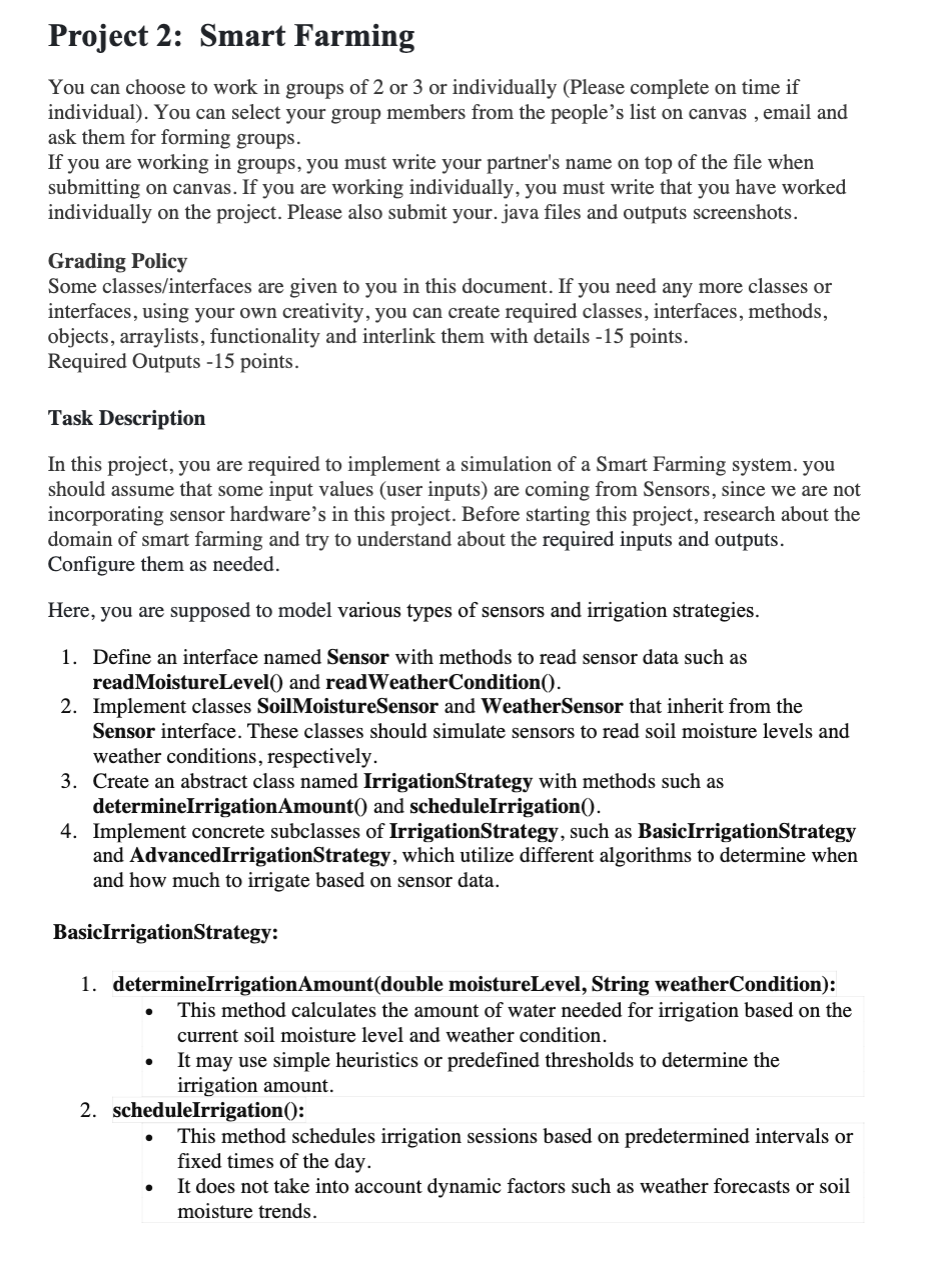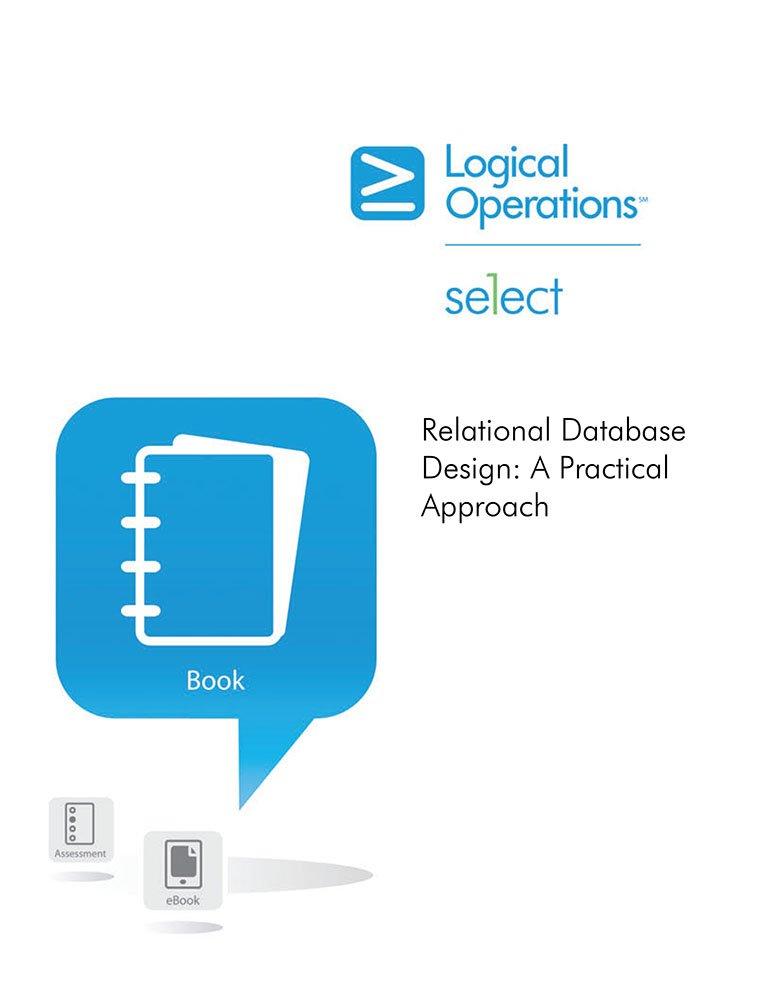Answered step by step
Verified Expert Solution
Question
1 Approved Answer
AdvancedIrrigationStrategy determineIrrigationAmount ( double moistureLevel, String weatherCondition, double cropWaterRequirement ) : This method calculates the optimal amount of water needed for irrigation considering the current
AdvancedIrrigationStrategy
determineIrrigationAmountdouble moistureLevel, String weatherCondition,
double cropWaterRequirement:
This method calculates the optimal amount of water needed for irrigation
considering the current soil moisture level, weather condition, and specific
water requirements of the crop.
adjustIrrigationSchedule:
This method dynamically adjusts the irrigation schedule based on realtime
sensor data, weather forecasts, and crop water demand.
considerSoilTypeAndTopography:
This method takes into account the soil type and topography of the field to
adjust irrigation strategies accordingly.
Develop a SmartIrrigationSystem class that coordinates the interaction between
sensors and irrigation strategies. This class should have methods to collect data from
sensors user inputs and invoke appropriate irrigation strategies.
Use the existing SmartIrrigationSystem class to include methods for crop
management, such as monitorCropHealth and applyFertilizer
Implement classes for any types of crops, each inheriting from a common Crop
superclass. Each crop class should include properties such as growth stage, nutrient
requirements, and susceptibility to diseases.
Create interfaces for the decisionmaking module, such as DecisionMaker, with
methods like makeIrrigationDecision makeFertilizationDecision and
makePestControlDecision
Implement concrete classes that implement the DecisionMaker interface.
Include additional functionality, such as detecting pest presence or measuring nutrient
levels in the soil.
Incorporate a menu interface component that allows farmers to interact with the system,
view sensor data, and adjust settings for crop management.
Develop classes to represent different types of livestock, such as cattle, poultry, and
sheep, each inheriting from a common Livestock superclass. Include properties such as
health status, diet requirements, and production metrics eg milk yield, egg
production
Implement classes for managing livestock health and productivity, with properties such
as LivestockHealthMonitor and LivestockProductionManager, with methods to
monitor health indicators, administer medication, and optimize feeding schedules.
Enhance the menu interface to provide farmers with insights into both crop and
livestock health, enabling them to make informed decisions for overall farm
productivity.
Implement messages to notify farmers of potential health issues or production anomalies
in crops and livestock Project : Smart Farming
You can choose to work in groups of or or individually Please complete on time if
individual You can select your group members from the people's list on canvas, email and
ask them for forming groups.
If you are working in groups, you must write your partner's name on top of the file when
submitting on canvas. If you are working individually, you must write that you have worked
individually on the project. Please also submit your. java files and outputs screenshots.
Grading Policy
Some classesinterfaces are given to you in this document. If you need any more classes or
interfaces, using your own creativity, you can create required classes, interfaces, methods,
objects, arraylists, functionality and interlink them with details points.
Required Outputs points.
Task Description
In this project, you are required to implement a simulation of a Smart Farming system. you
should assume that some input values user inputs are coming from Sensors, since we are not
incorporating sensor hardware's in this project. Before starting this project, research about the
domain of smart farming and try to understand about the required inputs and outputs.
Configure them as needed.
Here, you are supposed to model various types of sensors and irrigation strategies.
Define an interface named Sensor with methods to read sensor data such as
readMoistureLevel and readWeatherCondition
Implement classes SoilMoistureSensor and WeatherSensor that inherit from the
Sensor interface. These classes should simulate sensors to read soil moisture levels and
weather conditions, respectively.
Create an abstract class named IrrigationStrategy with methods such as
determineIrrigationAmount and scheduleIrrigation
Implement concrete subclasses of IrrigationStrategy, such as BasicIrrigationStrategy
and AdvancedIrrigationStrategy, which utilize different algorithms to determine when
and how much to irrigate based on sensor data.
BasicIrrigationStrategy:
determineIrrigationAmountdouble moistureLevel, String weatherCondition:
This method calculates the amount of water needed for irrigation based on the
current soil moisture level and weather condition.
It may use simple heuristics or predefined thresholds to determine the
irrigation amount.
scheduleIrrigation:
This method schedules irrigation sessions based on predetermined intervals or
fixed times of the day.
It does not take into account dynamic factors such as weather forecasts or soil
moisture trends.

Step by Step Solution
There are 3 Steps involved in it
Step: 1

Get Instant Access to Expert-Tailored Solutions
See step-by-step solutions with expert insights and AI powered tools for academic success
Step: 2

Step: 3

Ace Your Homework with AI
Get the answers you need in no time with our AI-driven, step-by-step assistance
Get Started


